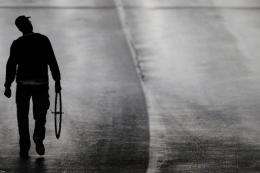You glimpse a stranger standing in the street. The light is hazy and the person's face and clothing are indistinct. Who is it? Chances are you will think it is a man—and the reason for this is a survival reflex, according to an unusual study published.
You glimpse a stranger standing in the street. The light is hazy and the person's face and clothing are indistinct. Who is it? Chances are you will think it is a man—and the reason for this is a survival reflex, according to an unusual study published on Wednesday.
Psychologists at the University of California at Los Angeles delved into our quest for visual clues when we assess other people.
They asked male and female students to look at 21 human silhouettes, all of them the same height, but with a progressively changing waist-to-hip ratio.
The figures began with an obviously female "hourglass" figure and, after incremental changes, ended with an obviously male "hunk" figure.
The volunteers were asked to say whether each of the 21 silhouettes was male or female, the idea being to identify the point where they saw a shift in gender.
What was striking, said researcher Kerri Johnson, was a preference for the volunteers to deem a shape to be a man whenever it was ambiguous—or could readily have been taken for a woman.
"I was surprised by the size of the effect. It was a much stronger effect than I ever imagined," Johnson said in a phone interview.
In the natural world, the demarcation between a woman's shape and man's shape comes when the ratio of the waist and hip circumferences is 0.8.
But the volunteers, on average, placed the boundary at 0.68. In other words, an identifiable female shape for them was close to the idealised curves of a pinup.
Johnson's team carried out three further studies, using a slightly different methods to see whether their approach had been skewed, and found that the bias in favour of men was unchanged.
Are these errors in perception?
Not so, said Johnson, who believes it to be an ancestral survival mechanism.
A man is likelier than a woman to be a bigger physical threat and our default perception is to prepare for risk: it's better to be safe than sorry.
"We suspect that this might be for a self-protective reason," she said.
"If you are walking down a dark alley at night, a woman poses no great physical threat to you in general, but if you encounter an unknown man, he's more likely to have a physical formidability that could pose some risks."
Johnson conceded that there could be cultural or ethnic factors which influence judgement but argued that the same kind of bias would prevail anywhere.
"I think it's entirely likely that if we were to test this in different populations we would probably have the same basic effect, the same pattern of judgement, although the strength of the judgement might vary," she said.
The findings show how gender stereotypes can be reinforced, sometimes dangerously so, said the study.
A woman could struggle if she has a body shape that is perceived as masculine and thus unattractive.
"Consistent with other research, this is likely to produce preferences for extreme body shapes, particularly for women," said the study.
The paper appears in the British journal Proceedings of the Royal Society B.
Journal information: Proceedings of the Royal Society B
(c) 2012 AFP



















